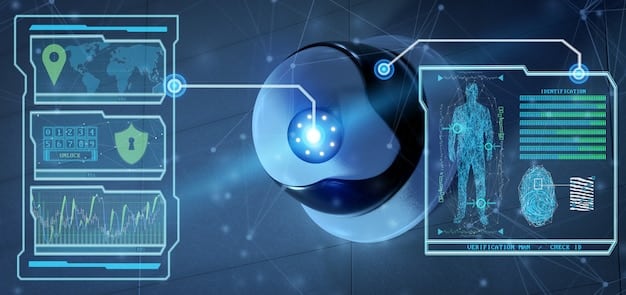Behavioral Biometrics: Prevent Account Takeover in US Organizations

Behavioral biometrics uses unique patterns in how individuals interact with devices and systems to verify identity, detect anomalies indicative of fraud, and prevent account takeover in US organizations by analyzing typing rhythm, mouse movements, and other behavioral traits.
Is your US-based organization looking for a cutting-edge way to safeguard against fraud and unauthorized access? Behavioral biometrics: Using Authentication Patterns to Detect Account Takeover and Fraud in US Organizations offers a sophisticated layer of security by analyzing the way users interact with their devices.
Understanding Behavioral Biometrics
Behavioral biometrics is an innovative security approach gaining traction in the US. It moves beyond traditional authentication methods by examining the unique ways individuals interact with technology.
How Behavioral Biometrics Works
Instead of relying solely on passwords or PINs, behavioral biometrics analyzes patterns such as typing speed, mouse movements, scrolling behavior, and even the way a person holds their mobile device. These patterns, unique to each user, create a behavioral profile.
This profile acts as a continuous authentication tool, monitoring user activity in real-time. Any deviation from the established norm raises a flag, indicating a potential security threat.
Benefits for US Organizations
- Enhanced Security: Adds a layer of security that’s difficult for fraudsters to mimic.
- Reduced Fraud: Helps detect and prevent account takeover, identity theft, and other fraudulent activities.
- Improved User Experience: Operates seamlessly in the background, minimizing friction for legitimate users.
- Compliance: Aids in meeting regulatory requirements for data security and fraud prevention.
Behavioral biometrics is a powerful tool for US organizations seeking to strengthen their security posture in a user-friendly way. It provides continuous authentication, improving fraud detection and adapting to each individual’s unique behavior.

Detecting Account Takeover with Behavioral Biometrics
Account takeover (ATO) is a major concern for US businesses. Using behavioral biometrics effectively combats this threat by identifying unauthorized access attempts.
Identifying Anomalous Behavior
When a hacker gains access to an account, their behavior will likely deviate from the account holder’s established patterns. Behavioral biometrics systems are designed to detect these subtle differences.
For example, a fraudster might type faster or slower than the legitimate user, or they might navigate the application in an unfamiliar way. These anomalies trigger alerts, prompting further investigation.
Real-Time Monitoring and Intervention
Behavioral biometrics systems continuously monitor user activity, providing real-time insights into potential threats. This allows organizations to respond quickly to suspicious behavior.
- Automated Alerts: Systems automatically flag suspicious activity.
- Step-Up Authentication: Request additional verification methods when anomalies are detected.
- Session Termination: Terminate suspicious sessions immediately to prevent further damage.
By continuously analyzing user behavior, organizations can identify and respond to account takeover attempts in real-time, minimizing financial losses and reputational damage.
Applications of Behavioral Biometrics in Fraud Prevention
Beyond account takeover, behavioral biometrics plays a crucial role in preventing various types of fraud in US organizations.
Combating Identity Theft
By verifying the user’s identity based on their unique behavioral patterns, behavioral biometrics makes it harder for identity thieves to impersonate legitimate customers.
Organizations can use behavioral biometrics to strengthen their know-your-customer (KYC) processes, ensuring that only authorized individuals can access sensitive data and perform transactions.
Preventing Payment Fraud
Behavioral biometrics can also help prevent fraudulent payment transactions by analyzing the user’s behavior during the checkout process. Any unusual patterns, such as a sudden change in typing speed or mouse movements, can indicate a fraudulent transaction.
Insider Threat Detection
In addition to external threats, behavioral biometrics can also help detect insider threats. By monitoring employee behavior, organizations can identify employees who may be engaging in malicious activity, such as accessing unauthorized data or stealing sensitive information.
Behavioral biometrics reduces threats across various fraud types in the US including identity theft, payment fraud, and insider threats by providing added layers of security and continuous monitoring.

Implementing Behavioral Biometrics in Your Organization
Implementing behavioral biometrics requires careful planning and execution. Consider these factors to ensure a successful deployment in your US organization.
Choosing the Right Solution
There are several behavioral biometrics solutions available on the market. Evaluate vendors based on their technology, accuracy, scalability, and integration capabilities.
Consider a solution that offers a wide range of behavioral indicators, real-time monitoring, and seamless integration with your existing security infrastructure.
User Enrollment and Training
The initial enrollment process is crucial for establishing accurate behavioral profiles. Ensure that users understand how the system works and why it’s important for security.
- Clear Communication: Explain the benefits of behavioral biometrics to users.
- Privacy Considerations: Address user privacy concerns openly and transparently.
- Ongoing Monitoring: Continuously monitor and refine behavioral profiles for optimal accuracy.
Integration with Existing Systems
Behavioral biometrics should integrate seamlessly with your existing security systems, such as identity and access management (IAM) and fraud detection platforms.
This integration allows you to leverage behavioral insights across your entire security ecosystem, improving threat detection and response capabilities.
To implement Behavioral Biometrics follow these guidelines: choose a solution that fits your organization, clearly communicate the process to employees, and ensure it integrates with your current systems.
The Future of Behavioral Biometrics in the US
Behavioral biometrics is rapidly evolving, leading to some exciting opportunities for businesses in the US.
Advancements in AI and Machine Learning
AI and machine learning are playing an increasingly important role in behavioral biometrics. These technologies enable systems to learn and adapt to evolving user behavior, improving accuracy and reducing false positives.
AI-powered behavioral biometrics systems can also detect more subtle anomalies that might be missed by traditional rule-based systems.
Expanding Use Cases
While behavioral biometrics is currently used primarily for fraud prevention and account takeover detection, its applications are expanding to other areas, such as:
- Workplace Security: Monitoring employee behavior to detect insider threats and prevent data breaches.
- Healthcare: Verifying patient identity for secure access to medical records and telehealth services.
- Government: Enhancing the security of government systems and preventing fraud in public programs.
The rapid advancements in AI and machine learning are driving the growth of behavioral biometrics, leading to new and innovative applications across various industries in the US.
Behavioral biometrics improves accuracy, decreases false positives, and can be applied across security, healthcare and government institutions.
Addressing Privacy Concerns
Behavioral biometrics raises important privacy concerns. It is crucial to address these concerns proactively to maintain user trust and comply with regulations in the US.
Data Collection and Storage
Be transparent about the types of behavioral data collected and how it is stored. Implement robust security measures to protect user data from unauthorized access.
Organizations should also comply with privacy regulations such as the California Consumer Privacy Act (CCPA) and the General Data Protection Regulation (GDPR), if applicable.
User Consent and Control
Obtain user consent before collecting behavioral data. Provide users with the ability to access, correct, and delete their data.
Organizations should also give users control over the types of behavioral data collected and how it is used. Data anonymization and pseudonymization techniques can ensure the privacy of user accounts.
Transparency regarding the ways that user data is used will improve trust in the institutions and businesses that are working with their data.
| Key Point | Brief Description |
|---|---|
| 🔑 Enhanced Security | Adds a hard-to-mimic security layer. |
| 🛡️ Fraud Reduction | Helps prevent account takeover and identity theft. |
| 📈 Expanding Use | Growing applications in security, healthcare and government. |
| 👤 Identity Verification | Can strengthen the customer verification process. |
Frequently Asked Questions
▼
It analyzes unique patterns in how people interact with devices, like typing rhythm and mouse movements, to verify identity and detect fraud. It offers user behavior analysis for better data privacy of individual accounts.
▼
By continuously monitoring user behavior, it detects deviations from established patterns, flagging suspicious activity that could indicate an unauthorized user trying to takeover an account from an actual, authorized account holder through phishing or similar methods.
▼
Benefits include enhanced security, reduced fraud, improved user experience (as it operates seamlessly in the background), and help with meeting regulatory requirements for secure data keeping.
▼
Organizations must choose the right solution, train users, and integrate the technology within their existing security systems, enhancing overall fraud detection and data compliance for greater user data privacy.
▼
Yes, it raises privacy issues regarding data collection and storage, so organizations must be transparent, obtain user consent, and provide control over data usage to comply with existing data privacy laws.
Conclusion
Behavioral biometrics: Using Authentication Patterns to Detect Account Takeover and Fraud in US Organizations offers a promising avenue for enhancing security and combating fraud in the US. By understanding its principles, applications, and implementation strategies, organizations can leverage this technology to protect their assets and ensure a safer online experience for their customers. It provides continuous risk assessment for user data privacy.





